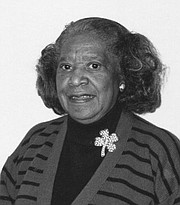NASA names D.C. headquarters for engineer Mary W. Jackson of ‘Hidden Figures’ fame
Free Press wire reports | 7/2/2020, 6 p.m.
WASHINGTON - The early African-American women at NASA will not be hidden anymore.
NASA administrator Jim Bridenstine announced last week that the agency’s headquarters in Washington has been named after Hampton native Mary Winston Jackson, the first African-American female engineer at NASA.
Her work as a mathematician and aerospace engineer at NASA, and that of Katherine G. Johnson and Dorothy Vaughan in the West Area Computing Unit at NASA’s Langley Research Center in Hampton, caught widespread national attention in the 2016 book “Hidden Figures: The American Dream and the Untold Story of the Black Women Mathematicians Who Helped Win the Space Race.”
The book by Margot Lee Shetterly was made into a popular movie that same year, with Mrs. Jackson’s character played by award-winning actress Janelle Monáe.
Mrs. Jackson, a 1942 graduate of Hampton Institute with a dual degree in math and physical sciences, went on to lead programs influencing the hiring and promotion of women in NASA’s science, technology, engineering and mathematics careers. In 2019, she was posthumously awarded the Congressional Gold Medal.
“Mary W. Jackson was part of a group of very important women who helped NASA succeed in getting American astronauts into space. Mary never accepted the status quo. She helped break barriers and open opportunities for African Americans and women in the field of engineering and technology,” Mr. Bridenstine said in a statement released June 24.
“Today, we proudly announce the Mary W. Jackson NASA Headquarters building. It appropriately sits on ‘Hidden Figures Way,’ a reminder that Mary is one of many incredible and talented professionals in NASA’s history who contributed to this agency’s success. Hidden no more, we will continue to recognize the contributions of women, African-Americans and people of all backgrounds who have helped construct NASA’s successful history to explore.”
In 2019, after a bipartisan bill by Sens. Ted Cruz, Ed Markey, John Thune and Bill Nelson made its way through Congress, the portion of E Street SW in front of NASA Headquarters was renamed Hidden Figures Way.
Mrs. Jackson died in 2005. Her family was proud of NASA’s latest recognition.
“We are honored that NASA continues to celebrate the legacy of our mother and grandmother Mary W. Jackson,” said Carolyn Lewis, Mrs. Jackson’s daughter. “She was a scientist, humanitarian, wife, mother and trailblazer who paved the way for thousands of others to succeed, not only at NASA, but throughout this nation.”
After graduating from Hampton, Mrs. Jackson initially accepted a job as a math teacher in Calvert County, Md. She went on to work as a bookkeeper, marry, start a family and work as a secretary for the U.S. Army before her aerospace career would take off.
She was recruited in 1951 by the National Advisory Committee for Aeronautics, the precursor agency to NASA, and started as a research mathematician known as a human computer at Langley.
After two years working under Dorothy Vaughan in the segregated West Area Computing Unit, she received an offer to work with NASA’s Supersonic Pressure Tunnel, a wind tunnel capable of blasting models with winds approaching twice the speed of sound. Her supervisor suggested she enter a training program to become an engineer. She needed special permission to join the classes, which were held in the all-white Hampton High School.
After completing the courses, Mrs. Jackson became NASA’s first African-American female engineer in 1958. During the course of her career with the space agency, she authored or co-authored numerous research reports focused largely on the behavior of the boundary layer of air around airplanes. She retired in 1985. “The nation is beginning to awaken to the greater need to honor the full diversity of people who helped pioneer our great nation,” Mr. Bridenstine said. “Over the years, NASA has worked to honor the work of these ‘Hidden Figures’ in various ways, including naming facilities, renaming streets and celebrating their legacy.
“We know there are many other people of color and diverse backgrounds who have contributed to our success, which is why we’re continuing the conversations started about a year ago with the agency’s Unity Campaign. NASA is dedicated to advancing diversity, and we will continue to take steps to do so.”








